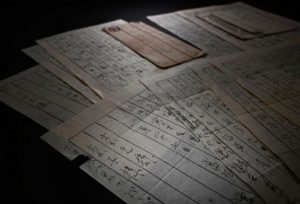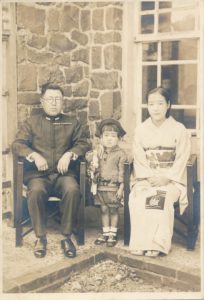Documenting Hiroshima of 1946: January 27, father writes letter to family, unaware of daughter’s death
Jan. 27, 2025
by Maho Yamamoto, Staff Writer
On January 27, 1946, Kenkichi Okubo, 40 at the time, who was serving in Japan’s Navy, wrote a letter to his wife and daughter. Mr. Okubo, who died in 1979 at the age of 74, had continued moving from place to place overseas after the war, unaware that his only daughter, Chikako, then 11 and a fifth-grader at Nakajima National School (present-day Nakajima Elementary School, in Hiroshima’s Naka Ward), had died in the atomic bombing.
In the letter he indicated that he was on board a vessel originating from the Malaysian port town of Batu Pahat. He wrote, “How are you doing at school, Chikako? I believe you are well and going to school as always.” He was aware of the situation in Hiroshima through telegrams and newspapers, but it is thought that he was unable to be in contact with his wife, Sakae, who died in 2013 at the age of 98.
On August 6, 1945, Chikako had left their home in the area of Yoshijima-hagoromomachi (in Hiroshima’s present-day Naka Ward), saying “I’ll be back,” but never returned. The family had just moved to Hiroshima, relying on relatives, to avoid the series of air raids on Sasebo in Nagasaki Prefecture that happened in June and, as such, Chikako had not been part of the group evacuations of school children. Although Sakae searched for Chikako, she was unable to locate even her remains. As Sakae described in Ryuto (in English, ‘Floating Lanterns’), a collection of memorials published in 1971, “Our only child, whom we loved and raised like a jewel in our palms.”
Kenkichi learned of his daughter’s death while in Singapore in May 1946. In a letter dated May 19, he wrote, “I wonder if I, a father who stands on a battlefield, could trade my life for that of my beloved child. Forgive me, my child. I recall your loving gestures from bygone days. I am alone on the upper deck. I only pray while in the far south that the spirit of my deceased child may rest in peace.” He also sent warm words to his wife. “You have endured great grief,” he wrote. After being demobilized from the military in August, he lived in Hiroshima.
The couple adopted a girl five or six years after the war. Tomoko Hara, 81, now lives in Osaka City. Her biological father, a physician, had been killed in the atomic bombing, and her mother died five years after the bombing. Kenkichi would always wait patiently for Tomoko to return home from school, and it is said that he would take her to Miyajima and to the factory of Chichiyasu, a yogurt company. Ms. Hara recalled, “He did everything for me with so much love that he had been unable to do for Chikako.”
Chikako’s remains were learned to have been enshrined in the Atomic Bomb Memorial Mound in Peace Memorial Park (in Hiroshima’s Naka Ward) and, in 1975, they were handed over to Sakae.
(Originally published on January 27, 2025)
On January 27, 1946, Kenkichi Okubo, 40 at the time, who was serving in Japan’s Navy, wrote a letter to his wife and daughter. Mr. Okubo, who died in 1979 at the age of 74, had continued moving from place to place overseas after the war, unaware that his only daughter, Chikako, then 11 and a fifth-grader at Nakajima National School (present-day Nakajima Elementary School, in Hiroshima’s Naka Ward), had died in the atomic bombing.
In the letter he indicated that he was on board a vessel originating from the Malaysian port town of Batu Pahat. He wrote, “How are you doing at school, Chikako? I believe you are well and going to school as always.” He was aware of the situation in Hiroshima through telegrams and newspapers, but it is thought that he was unable to be in contact with his wife, Sakae, who died in 2013 at the age of 98.
On August 6, 1945, Chikako had left their home in the area of Yoshijima-hagoromomachi (in Hiroshima’s present-day Naka Ward), saying “I’ll be back,” but never returned. The family had just moved to Hiroshima, relying on relatives, to avoid the series of air raids on Sasebo in Nagasaki Prefecture that happened in June and, as such, Chikako had not been part of the group evacuations of school children. Although Sakae searched for Chikako, she was unable to locate even her remains. As Sakae described in Ryuto (in English, ‘Floating Lanterns’), a collection of memorials published in 1971, “Our only child, whom we loved and raised like a jewel in our palms.”
Kenkichi learned of his daughter’s death while in Singapore in May 1946. In a letter dated May 19, he wrote, “I wonder if I, a father who stands on a battlefield, could trade my life for that of my beloved child. Forgive me, my child. I recall your loving gestures from bygone days. I am alone on the upper deck. I only pray while in the far south that the spirit of my deceased child may rest in peace.” He also sent warm words to his wife. “You have endured great grief,” he wrote. After being demobilized from the military in August, he lived in Hiroshima.
The couple adopted a girl five or six years after the war. Tomoko Hara, 81, now lives in Osaka City. Her biological father, a physician, had been killed in the atomic bombing, and her mother died five years after the bombing. Kenkichi would always wait patiently for Tomoko to return home from school, and it is said that he would take her to Miyajima and to the factory of Chichiyasu, a yogurt company. Ms. Hara recalled, “He did everything for me with so much love that he had been unable to do for Chikako.”
Chikako’s remains were learned to have been enshrined in the Atomic Bomb Memorial Mound in Peace Memorial Park (in Hiroshima’s Naka Ward) and, in 1975, they were handed over to Sakae.
(Originally published on January 27, 2025)









